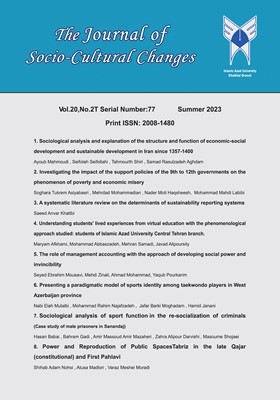Representation of power in the production of the social urban space Tabriz of the constitutional era and the first Pahlavi
Subject Areas : Social Evolutionsshahab adamnavasi 1 , Atusa Moderi 2 , Varaz Christian Moradi 3
1 - PhD student in urban planning, central Tehran branch, Islamic Azad University, Tehran, Iran
2 - Associate Professor of Urban Planning Department, Central Tehran Branch, Islamic Azad University, Tehran, Iran.
3 - Associate Professor of Urban Planning Department, Central Tehran Branch, Islamic Azad University, Tehran, Iran
Keywords: Power, Tabriz, Urban Space, production of space, Qajar (Constitution) and first Pahlavi,
Abstract :
The concept of urban space is always facing many complications. An important part of urban spaces are public spaces. Confronting space as a commodity, government intervention and government programs have led to the monopoly of public spaces. The purpose of this research is to understand the process of production of public spaces in the city through power relations. For this purpose, power conflicts in the political, cultural-social and economic environment of Tabriz were investigated in two periods and sources such as documents and texts, maps and historical photos were used. The methodology of this study is in two stages, in the first stage, determining the indicators based on the ANT network technique and theoretical coding of the texts and documents of each course, and in the second stage, the analysis of these indicators is based on the power mechanism techniques, and finally, determining the power technology. Two discontinuities in this period, what is obtained from this research is that in the late Qajar and first Pahlavi, contrary to what is expected from a civil society, most of the spatial representations, apart from the constitution, instead of involving all people And the activists in the process of space production have been dominated by the rulers. However, due to the network nature of power, the resistances produced by other actors in the form of semiotic production and social production have been able to intervene in the process of space production to some extent and assert their right to urban spaces.
_||_


